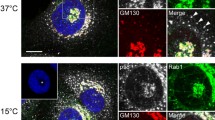Abstract
The endoplasmic reticulum (ER)-Golgi system has been studied using biochemical, genetic, electron and light microscopic techniques. We now understand many aspects of trafficking from the ER to the Golgi apparatus, including some of the signals and mechanisms for selective retention and retrieval of ER resident proteins and export of cargo proteins. Proteins that leave the ER emerge in ‘export complexes’ or ER ‘exit sites’ and accumulate in pleiomorphic transport carriers referred to sometimes as VTCs or intermediate compartments. These structures then transit from the ER to the Golgi apparatus along microtubules using the dynein/dynactin motor and fuse with the cis cisterna of the Golgi apparatus. Many proteins (including vSNAREs, ERGIC53/p58 and the KDEL receptor) must cycle back to the ER from pre-Golgi intermediates or the Golgi. We will discuss both the currently favored model that this cycling occurs via 50-nm COPI-coated vesicles and in vivo evidence that suggests retrograde trafficking may occur via tubular structures.
Similar content being viewed by others
Author information
Authors and Affiliations
Corresponding author
Rights and permissions
About this article
Cite this article
Murshid, A., Presley, J.F. ER-to-Golgi transport and cytoskeletal interactions in animal cells. CMLS, Cell. Mol. Life Sci. 61, 133–145 (2004). https://doi.org/10.1007/s00018-003-3352-9
Issue Date:
DOI: https://doi.org/10.1007/s00018-003-3352-9




